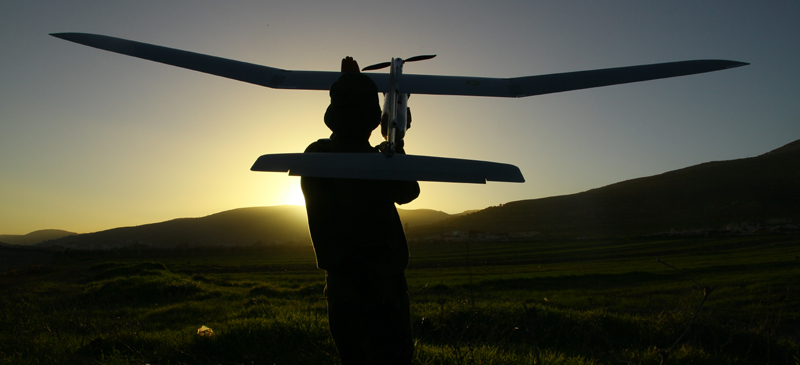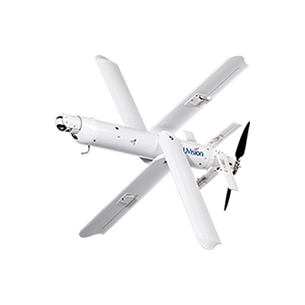As we discuss in our ongoing 3D Printing Drone Swarms series, additive manufacturing (AM) will play an increasing role in the production of all manner of semi-sentient robots. This has been demonstrated by unmanned aerial vehicles (UAVs), which are now being made in part with 3D printing for lightweight, custom designs. For this reason, we expect AM to be used for other drone-style bots as well, often for military purposes.

Elbit Skylark C a 15-kilogram drone with a five-hour flight time.
In the previous article in this series, I’ve tried to show you the relevance of drones and why they have been much more important than you may think in modern wars. From the 80s to the present day, drones have been critical, but why is 3D printing important to unmanned aerial vehicles (UAVs)? And why is the future of drones and the future of 3D printing so intertwined?
One part of this is historical accident. A drone boom in the United States saw many different branches of the military suddenly want many different types of drones. Production runs were small and everyone had their very own specifications. Many companies jumped in and naturally used 3D printing to prototype. Because firms such as Paramount Industries, Digital Harvest and Solid Concepts had, by then, years of experience in 3D printing aircraft prototypes and functional military parts, we as an industry could provide these components quickly and competently (Paramount was bought by 3D Systems and the latter two by Stratasys). There were long-lasting relationships in place between 3D printing services, design departments, defense contractors and industry. This brought confidence, trust and, most importantly, a thorough understanding of what 3D printing could and could not do in the mid ’90s to the mid-2000s.
The drone boom was accelerated when, during the 1990 Gulf War, the U.S. had to borrow UAVs from Israel for artillery targeting and deep penetration missions. At the same time, a key element of the U.S. campaign against Iraqi radar defenses was the use of now-old Chukar drones, of which the US was hastily able to put a few back into service. The Big Safari group’s efforts of combining UAVs, decoy drones and command-and-control aircraft, jamming aircraft and fighters, and Rivet Joint aircraft to take on sophisticated air defenses in a concerted fashion was inspired by and coached by Israeli success in 1982 with Operation Mole Cricket. Drones were no longer toys, or exciting possibilities. They were key to large U.S. invasion campaigns.
Upon winning their orders, many of these firms had simply already had flying or partially functional prototypes with 3D printed parts. When expedient and possible, the simplest thing for them was to continue printing these components on the final drone. This lead to more confidence within the U.S. military and defense establishment, which lead to more confident uses of 3D printing in final vehicles.
There was also a need for even more specialized UAVs, e.g., a drone made for sniffing out Iranian nuclear facilities or the North Korean missile program. For these vehicles, special adaptations were needed. At the same time, there was a real danger that, with excellent and numerous air defenses respectively, these countries would down the UAVs and learn their secrets. In the case of Iran, drone incursions into their aerospace seem to have inspired the country into considerable development and investment in drones itself. Indeed the country has very publicly shot down and rebuilt a Global Hawk for example. In other cases, drones with many 3D printed parts specifically made for those missions were reportedly used in their stead. This meant that if they were shot down there, they would not reveal the latest and greatest US technologies. This and other efforts further grew the adoption of 3D printing across the military-industrial complex.

Elbit Skylark i Lex is a smaller drone that is man packable and autonomous.
Fuel cells were 3D printed and housings for fuel cells. Complex winglets, wing parts, flap parts, and engine components were also made using 3D printing. Fuel tanks, housings, holders, mounts and complete wing and superstructure elements were also 3D printed. All across a drone, many parts were made with 3D printing because they were more functional that way, lighter or just cheaper to make.
Why Does 3D Printing Make So Much Sense for Drones?
- 3D printing is a fast and low-cost technology to get from the drawing board to real parts.
- 3D printing is a weight saving technology whereby you can print the same part with 40% less weight.
- With 3D printing, you can integrate a number of components into one, saving you costs in storage, tooling, capital, and making it easier for you to redesign parts. A fuel tank could be combined into a fuel tank with a sprout with a nozzle with a valve and holders.
- With 3D printing, you can make components that you can not make with other technologies.
- 3D printing makes it easy to redesign or repurpose designs and parts. In this manner, your losing drone design for the U.S. Coast Guard could be reworked quickly into a winning one for the Belgian Navy or Estonian border police.
- Drones had to work and your border guard either had video beyond the next hill or did not. If you sell nonworking armor to someone, it may take decades for them to figure this out. But a badly flying drone would be whispered across the defense grapevine rapidly. Redesigns and quick adaptations were not only useful but necessary.
- Quadcopters and large commercial drones became available for mapping and real estate applications, as well, and these were bought by militaries and governments. Companies were therefore pushed into rapid innovation to stay ahead of low-cost alternatives.
- Budget expectations were very low because people were able to buy affordable Israeli drones already.
- Drones had very little regulatory oversight or compliance requirements so they were an easy testbed for new technologies for 3D printing for Air Force and other planners.
- Drones had very little regulatory oversight or compliance requirements so they were a way for defense contractors to showcase new technologies and new designs.
- Drone numbers were very low with some production runs calling for 20 or 40 aircraft.
- Drones had been in U.S. service in some way for decades and were seen as remote control aircraft for the military, so expectations and familiarity were high while planners were unwilling to splurge on this technology, as opposed to larger, more expensive programs such as Star Wars or Stealth.
- Senior Air Force and other planners had been looking at super-secret 3D printed components often in the most cutting edge designs, which made them more knowledgeable of and more blasé about the technology.
- Polymers are much lighter than metals. With few safety rules and none of the expectation that a lot of these things would last 30 years, as many metal components were replaced with polymers as was feasible.
- The U.S. has had many wars in many different theaters across the last few decades, meaning that attrition was high on drones and information from the front led to better designs by companies and better requirements by militaries.
- Success and horror by Predator drone strikes killing civilians led to much global awareness and interest in drones.
- A fair bit of techno-optimism meant that drones were seen as transport tools and ways to bring the internet to everyone. This may yet be true, but, so far, it has lead to lots more investor cash into this arena than one may have thought.
- 3D printing and CAD, as well as a network of manufacturing companies able to make aerospace parts, have meant that the barriers to entry to the drone and aviation market have been greatly reduced.
- Success in one area, good theater video from MALE drones, led to an optimistic investment in other areas, bee-sized camera drones.

The Hero 30 pops out of a vehicle-mounted cylinder and can act as loitering ammunition.
After the U.S. drone boom, 3D printing was understood and used widely in the U.S. defense establishment. We as an industry had gone from a curiosity to an important technology for the largest armies of the Earth. With more new developments happening, more drones are being built to counter infinite uncertainties. But, rather than nestle the U.S. and its allies firmer in their saddles, drone development has opened up a pandora’s box. In the next installment, we’ll look at how drones have become the essential weapon in regional conflicts and how they’re being used by irregular and terrorist forces, as well. It seems that we as a technology are being drug down into places were we would rather not go.
Subscribe to Our Email Newsletter
Stay up-to-date on all the latest news from the 3D printing industry and receive information and offers from third party vendors.
You May Also Like
Precision at the Microscale: UK Researchers Advance Medical Devices with BMF’s 3D Printing Tech
University of Nottingham researchers are using Boston Micro Fabrication‘s (BMF) 3D printing technology to develop medical devices that improve compatibility with human tissue. Funded by a UK grant, this project...
3D Printing Webinar and Event Roundup: April 21, 2024
It’s another busy week of webinars and events, starting with Hannover Messe in Germany and continuing with Metalcasting Congress, Chinaplas, TechBlick’s Innovation Festival, and more. Stratasys continues its advanced training...
3D Printing Webinar and Event Roundup: March 17, 2024
It’s another busy week of webinars and events, including SALMED 2024 and AM Forum in Berlin. Stratasys continues its in-person training and is offering two webinars, ASTM is holding a...
3D Printed Micro Antenna is 15% Smaller and 6X Lighter
Horizon Microtechnologies has achieved success in creating a high-frequency D-Band horn antenna through micro 3D printing. However, this achievement did not rely solely on 3D printing; it involved a combination...





























